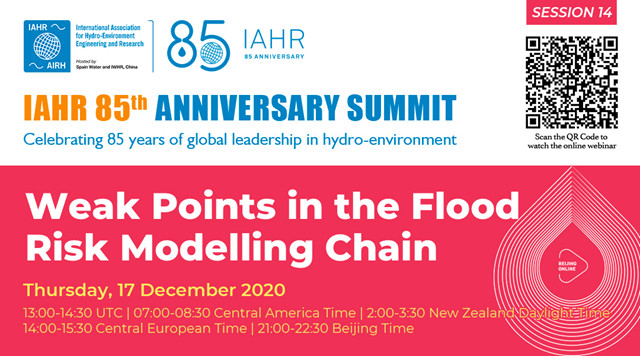Weak Points in the Flood Risk Modelling Chain - an initiative by the IAHR Committee on Flood Risk Management

Introduction Your contribution Collected weak points
Description of the initiative
In terms of human suffering, economic costs and damage to cultural and environmental heritage, floods have impacts increasing yearly worldwide. This means that we are far from properly predicting and managing flood risk. On the one hand, we are faced by the occurrence of more extreme climate-related events, transformations of rural landscapes and unsustainable urban population growth, which continuously changes the boundary conditions at which flood risk models must be adapted to deliver reliable results. On the other hand, our efforts are frustrated by limitations in our modelling capabilities. As a committee we would like to offer a platform to experts from academia and professionals, under the umbrella of the IAHR Technical Committee of Flood Risk Management, to share their experience in flood risk modelling, to discuss about these limitations, with the final aim of improving our modelling and risk mitigation capabilities.
Video IAHR 85th Anniversary – Weak Points in the Flood Risk Modelling Chain
How to contribute
With this call we seek contributions on: (i) identification of weak points/limits in the flood risk modelling chain; (ii) tools, best practices, bench mark data sets and case studies that could support our researcher and practitioner communities in dealing with those shortcomings. By the specific link, you can upload descriptions and materials related to a new weak point you would like to highlight or upload material to an existing point, making its definition more robust. Please, make sure that you have the right to upload and made available the material on the web, as it will be published under the Attribution-Non-commercial (CC BY-NC) license agreement. In case you do not hold the copyright, you can simply link the material of interest.
Reasons to contribute
All collected contributions and material will be made available to experts from academia and professionals on this web page, to increase the awareness on the weak points in the flood risk modelling chain, but also to support our researcher and practitioner communities as well as authorities for problem–solving in practice. All collected material will be peer-reviewed by the members of the Flood Risk Management Technical Committee before publication, to guarantee its high quality. After review each published title is assigned a doi. A second aim is the publication of a vision paper, on the behalf of the whole flood risk management community in the future, summarizing results from the initiative, i.e. that puts into light shortcomings in flood risk modelling, benchmark solutions and ways forward. This will be possible once we will have collected a relevant number of contributions. By uploading descriptions and materials you therefore agree that the committee may use the material for publications in a scientific matter, also acknowledge you.
Editorial Board
Editors
Daniela Molinari, DICA – Politecnico di Milano, Milano, Italy
Stefan Haun, University of Stuttgart, Stuttgart, Germany
Technical editor
Jenny Lu, Technical Division Program Officer, IAHR, Bejing, China
Advisory board
Francesco Ballio, DICA – Politecnico di Milano, Milano, Italy
Marian Muste, IIHR - Hydroscience & Engineering, The University of Iowa, Iowa city, United States of America
Alistair Barnett, HYDRA Software Ltd, Hamilton, New Zealand
Benjamin J. Dewals, University of Liege, Liege, Belgium
Copyright Agreement
Attribution-Non-commercial (CC BY-NC)

